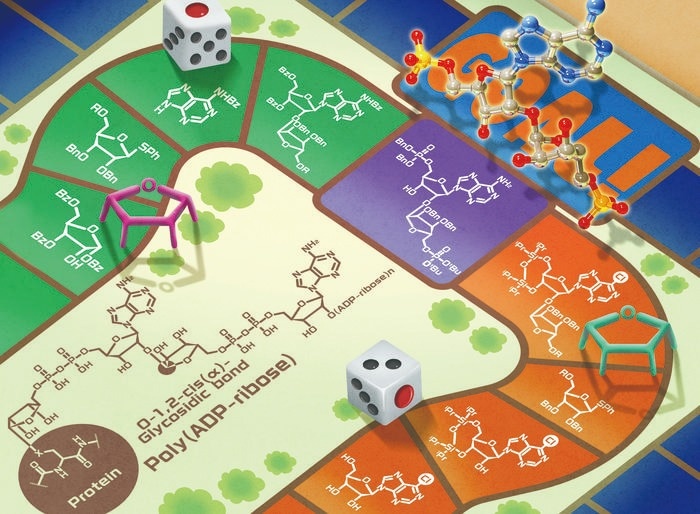The body’s inherent production of a specific sugar-based molecule plays a crucial role in various cellular functions, including growth, differentiation into different cell types, self-destruction if necessary, and more.
 Researchers at Gifu University’s Institute for Glyco-core Research have developed two synthetic approaches to produce a fragment of a molecule called poly(ADP-ribose). By developing two ways to synthesize the fragment, researchers may be able to better understand how it contributes to vital functions in the cell. Image Credit: Hiromune Ando and Hide-Nori Tanaka.
Researchers at Gifu University’s Institute for Glyco-core Research have developed two synthetic approaches to produce a fragment of a molecule called poly(ADP-ribose). By developing two ways to synthesize the fragment, researchers may be able to better understand how it contributes to vital functions in the cell. Image Credit: Hiromune Ando and Hide-Nori Tanaka.
This molecule, known as poly (adenosine diphosphate ribose) or poly(ADP-ribose), not only safeguards the cell's genome and repairs DNA but also regulates the inheritance of genes. Unraveling the precise mechanisms of poly(ADP-ribose) could offer valuable insights for disease prevention and treatments.
In pursuit of a deeper understanding, researchers from Gifu University's Institute for Glyco-core Research (iGCORE) in Japan have created two synthetic versions of an ADP-ribose fragment.
The study was reported in the European Journal of Organic Chemistry on September 23rd, 2023.
When cells engage in protein synthesis, they interpret genetic instructions to construct proteins. Throughout this process, certain molecules or molecular fragments can attach themselves to the protein, influencing post-translational modifications.
The poly(ADP-ribose) fragment, specifically the ribosyl adenosine 5′,5′′-diphosphate, could unveil distinct cellular functions. However, the natural variability of occurring fragments poses a challenge for scientists attempting to attribute comprehensive functions to them.
The problem is lack of the availability of homogeneous oligo- and poly(ADP-ribose) samples which are necessary for molecular-level studies to elucidate their detailed functions.”
Hide-Nori Tanaka, Study Co-Corresponding Author and Assistant Professor, iGCORE
Tanaka added, “To address this bottleneck and accelerate ADP-ribose biology, we developed two practical synthetic approaches to ribosyl adenosine 5',5"-diphosphate, a fragment of poly(ADP-ribose), for providing structurally well-defined ADP-ribose oligomer and polymer.”
Oligo- and poly(ADP-ribose) refers to the number of components that bind together to make up the ADP-ribose molecule.
The initial technique entailed a gradual assembly, utilizing a readily accessible solution to construct a framework.
Subsequently, researchers introduced carbohydrates to this framework. In contrast, the second method was simplified into a singular step. In this process, researchers worked with a known molecule, capable of binding to other molecules, extracted from a commercially available solution.
Both approaches yielded a shared precursor that transforms into a conjugation-ready building block, poised for integration in ADP-ribose synthesis, as outlined by Tanaka.
The next step is ADP-ribose oligomer synthesis using the building block we prepared in this paper. Our ultimate goal is to elucidate the detailed functions of oligo- and poly(ADP-ribose) by chemical biology approach using synthetic molecules.”
Hide-Nori Tanaka, Study Co-Corresponding Author and Assistant Professor, iGCORE
Source:
Journal reference:
Hagino, R., et al. (2023) Synthetic Approaches to Ribosyl Adenosine 5′,5′′-Diphosphate Fragment of Poly(ADP-ribose). European Journal of Organic Chemistry. doi.org/10.1002/ejoc.202300875.